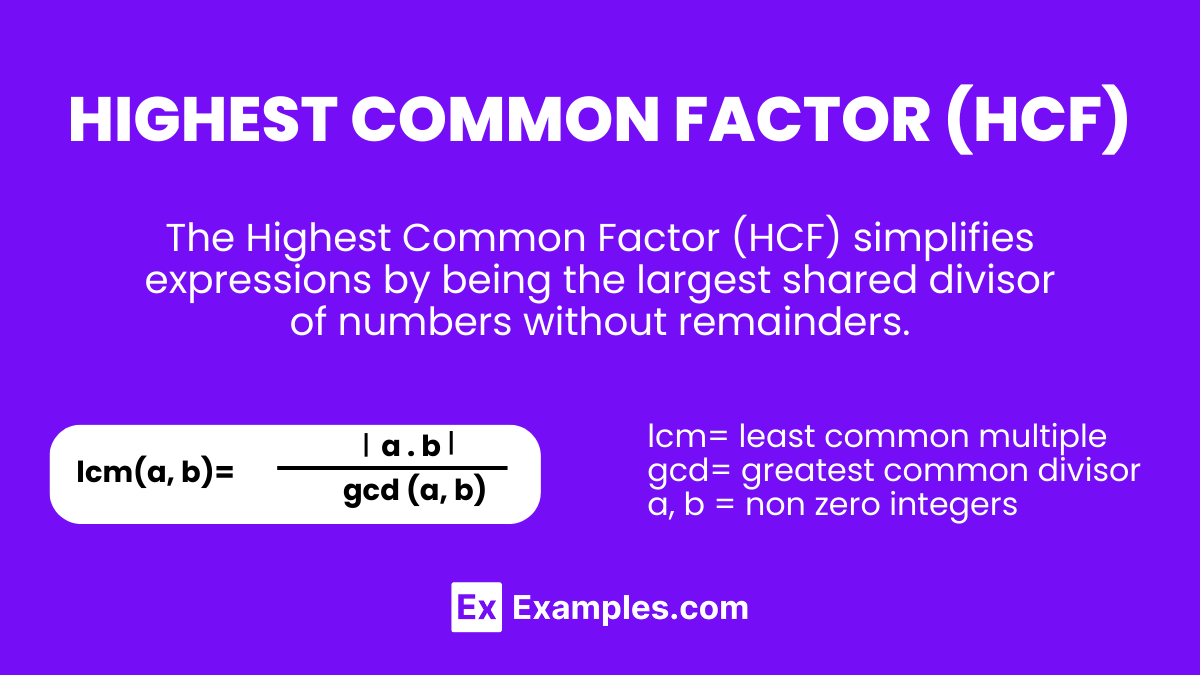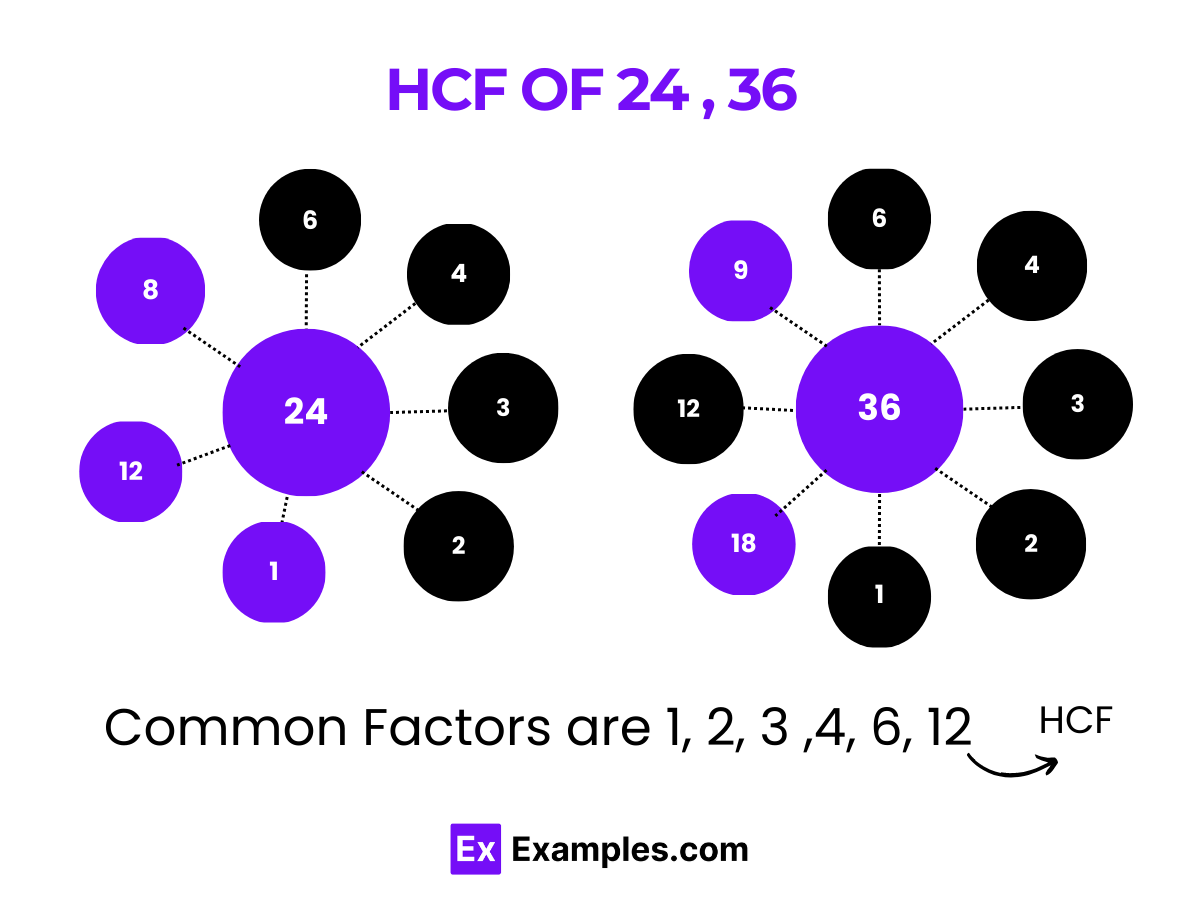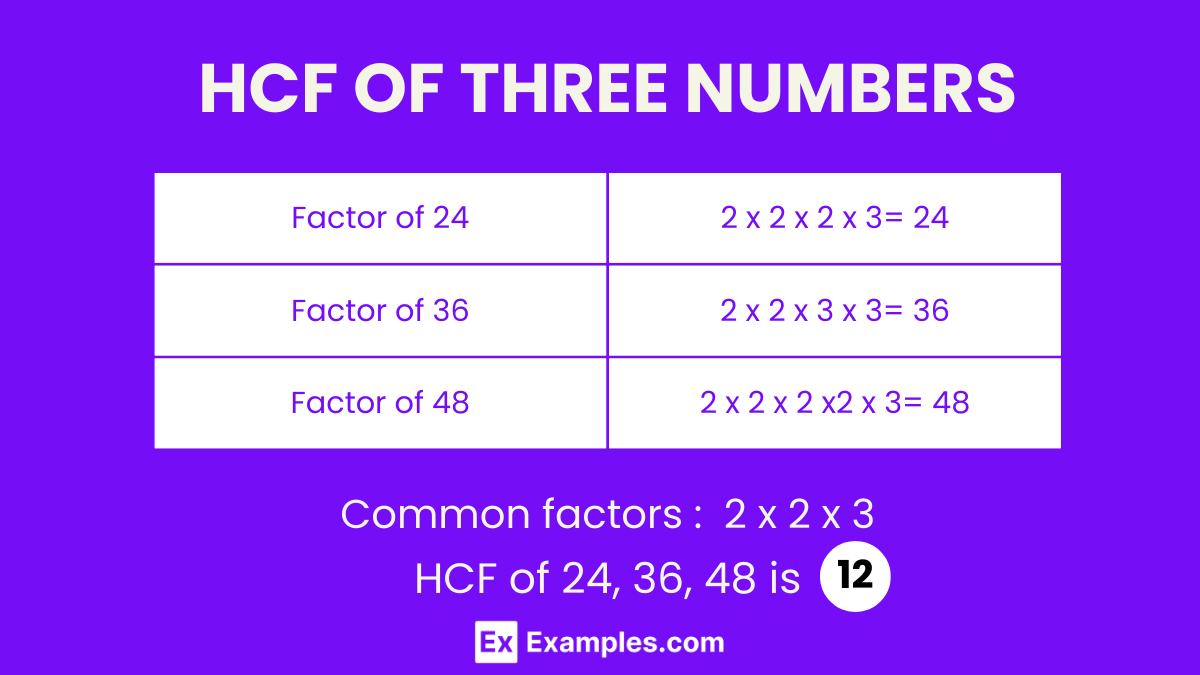Find the HCF of 14, 21, and 28 using the common division method.
2
3
7
14


The world of mathematics with our in-depth guide on the Highest Common Factor (HCF). This fundamental concept, essential for both basic arithmetic and advanced algebra, paves the way for simplifying fractions, solving equations, and understanding number properties. Through practical examples, this guide elucidates the process of finding the HCF, enhancing your problem-solving skills and mathematical fluency. Perfect for students, educators, and math enthusiasts aiming to fortify their understanding of core mathematical principles.
The Highest Common Factor (HCF), also known as the Greatest Common Divisor (GCD), is the largest number that divides two or more numbers without leaving a remainder. It’s a key concept in mathematics that helps in simplifying fractions, comparing ratios, and solving various problems involving whole numbers. In simple terms, if you have a set of numbers, the HCF is the biggest number that all of these numbers can be divided by evenly. This concept is not only fundamental in arithmetic but also plays a crucial role in algebra and number theory, making it an essential tool for students and mathematicians alike.
 Let’s find the HCF of 24 and 36.
Let’s find the HCF of 24 and 36.
Discover the essential methods to calculate the Highest Common Factor (HCF), a fundamental concept in mathematics that simplifies numbers and expressions. This guide will walk you through different techniques, accompanied by clear examples and step-by-step calculations to enhance your understanding and skills.
Prime factorization involves breaking down each number into its prime factors and then identifying the common prime factors to find the HCF.
Let’s find the HCF of 48 and 60.
HCF of 48 and 60 is 12.
The division method, also known as the Euclidean algorithm, is a systematic approach to finding the HCF by dividing the larger number by the smaller number until the remainder is zero.
Let’s Find the HCF of 105 and 45.
HCF of 105 and 45 is 15.
Grasping the properties of the Highest Common Factor (HCF) can significantly enhance your mathematical problem-solving skills. This guide delves into the fundamental characteristics of HCF, providing a clearer understanding of its applications and utility in various mathematical contexts.
The Highest Common Factor, by definition, is a positive integer. It represents the largest number that can divide two or more integers without leaving a remainder. This property is essential for simplifying fractions and finding equivalent ratios, making HCF a cornerstone in arithmetic and algebra.
When dealing with prime numbers, which are numbers greater than 1 that have no divisors other than 1 and themselves, the HCF is always 1. This is because prime numbers do not share any common factors other than 1, highlighting the fundamental aspect of prime numbers in number theory.
One of the most intriguing properties of HCF is its relationship with the Least Common Multiple (LCM). For any two numbers, the product of their HCF and LCM is equal to the product of the numbers themselves. This relationship is pivotal in solving problems that involve both HCF and LCM, providing a dual approach to understanding number relationships.
The Highest Common Factor cannot be greater than the smallest number among the ones being considered. This property is logical since the HCF is a factor that all the numbers share, and a factor is always less than or equal to the number itself.
One of the practical applications of HCF is in the simplification of fractions. By finding the HCF of the numerator and denominator, you can reduce fractions to their simplest form. This property is particularly useful in fraction addition, subtraction, multiplication, and division, ensuring the results are presented in the most simplified manner.
Dive into the intricate world of mathematics as we unravel the fundamental relationship between two key concepts: the Least Common Multiple (LCM) and the Highest Common Factor (HCF). This relationship is not merely a mathematical curiosity; it’s a powerful tool that bridges the gap between understanding individual numbers and how they interact within the mathematical universe.
| Aspect | LCM | HCF |
|---|---|---|
| Definition | The smallest common multiple that two or more numbers can divide into evenly. | The largest number that can evenly divide two or more numbers without a remainder. |
| Calculation | Utilizes the highest power of all prime factors present in the numbers. | Involves the lowest power of common prime factors across the numbers. |
| Mathematical Relation | Part of the equation: LCM×HCF=Product of the numbersLCM×HCF=Product of the numbers. | Integral to the relationship: HCF×LCM=Product of the numbersHCF×LCM=Product of the numbers. |
| Example | For 8 and 12, LCM = 24 (derived from 2323 and 22×322×3). | For 8 and 12, HCF = 4 (from the common 2222). |
| Usage | Ideal for finding the least common denominator in fractions and solving problems involving multiples. | Crucial for simplifying fractions, determining the greatest common divisor, and analyzing number properties. |
At the core of the relationship between LCM and HCF is a simple, yet profound equation:
HCF×LCM=Product of the two numbers
This equation signifies a deep connection between the LCM and HCF of any two numbers, asserting that their product is always equal to the product of the numbers themselves. This foundational principle applies universally to all pairs of integers and is instrumental in solving a wide array of mathematical problems.
Let’s solidify this concept with a concrete example, using the numbers 20 and 30 to explore their LCM and HCF.
The calculation not only validates the relationship but also highlights the seamless interplay between the HCF and LCM, demonstrating that the product of 10 (HCF) and 60 (LCM) of the numbers 20 and 30 equals the product of 20 and 30 themselves (600). This example serves as a testament to the reliability and applicability of the HCF-LCM relationship across different numerical scenarios.
Finding the Highest Common Factor (HCF) of three numbers involves identifying the largest number that divides all three numbers without any remainder. This process is crucial for simplifying fractions and solving problems that involve multiple numbers.

The HCF of 24, 36, and 48 is 12, which is the largest number that divides all three numbers evenly.
When dealing with four numbers, the process to find the HCF remains consistent with finding the greatest common divisor that evenly divides all four numbers.
The HCF of 16, 32, 48, and 64 is 16, showcasing the largest number that all four numbers can be divided by without a remainder.
Prime numbers are numbers that have only two distinct positive divisors: 1 and the number itself. The HCF of any two prime numbers is always 1, as they do not share any other divisors.
The HCF of any set of prime numbers, such as 13, 17, and 19, is always 1, reflecting the unique property of prime numbers having no common divisors other than 1.
In conclusion, understanding the Highest Common Factor (HCF) is fundamental in mathematics, offering essential insights into number theory and algebra. It simplifies expressions, aids in solving equations, and enhances problem-solving skills. Mastering HCF calculation methods enriches mathematical proficiency, making it a pivotal concept for students, educators, and math enthusiasts seeking to deepen their comprehension of mathematical relationships and operations.
Text prompt
Add Tone
How to Find Highest Common Factor (HCF)
Properties of the Highest Common Factor (HCF)
Relation between LCM and HCF
Find the HCF of 14, 21, and 28 using the common division method.
2
3
7
14
Using the Euclidean algorithm, find the HCF of 105 and 225.
5
10
25
15
Find the HCF of 44 and 88 using the ladder method.
22
11
44
88
Using the prime factorization method, find the HCF of 40 and 50.
5
10
15
20
Using the prime factorization method, find the HCF of 56 and 98.
7
14
28
49
Determine the HCF of 120 and 180 by listing the common factors.
20
30
40
60
Find the HCF of 81 and 54 using the division method.
9
18
27
36
Using the Euclidean algorithm, find the HCF of 48 and 64.
8
12
16
24
Find the HCF of 12 and 18.
6
7
8
9
Find the HCF of 24 and 36.
6
8
10
12
Before you leave, take our quick quiz to enhance your learning!

